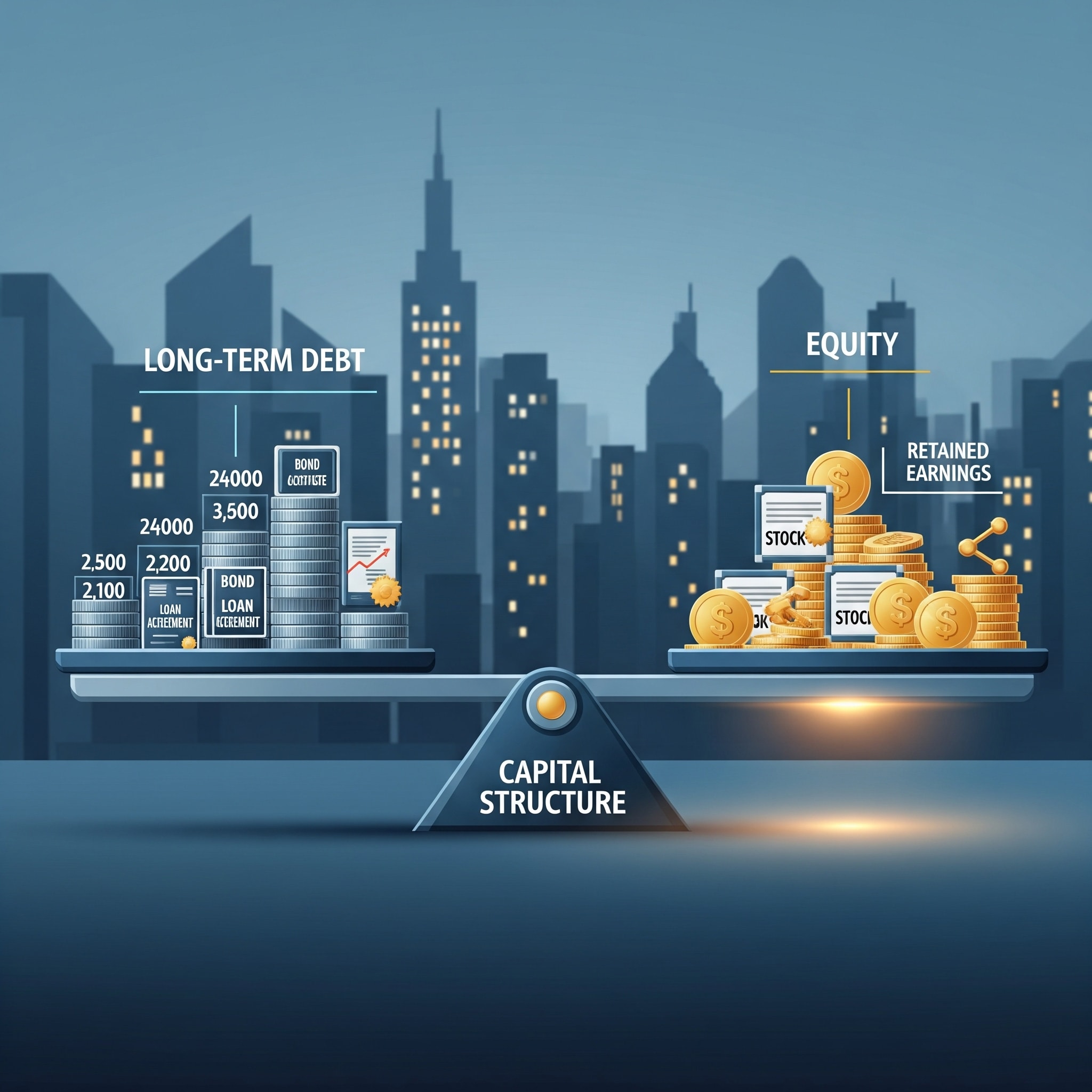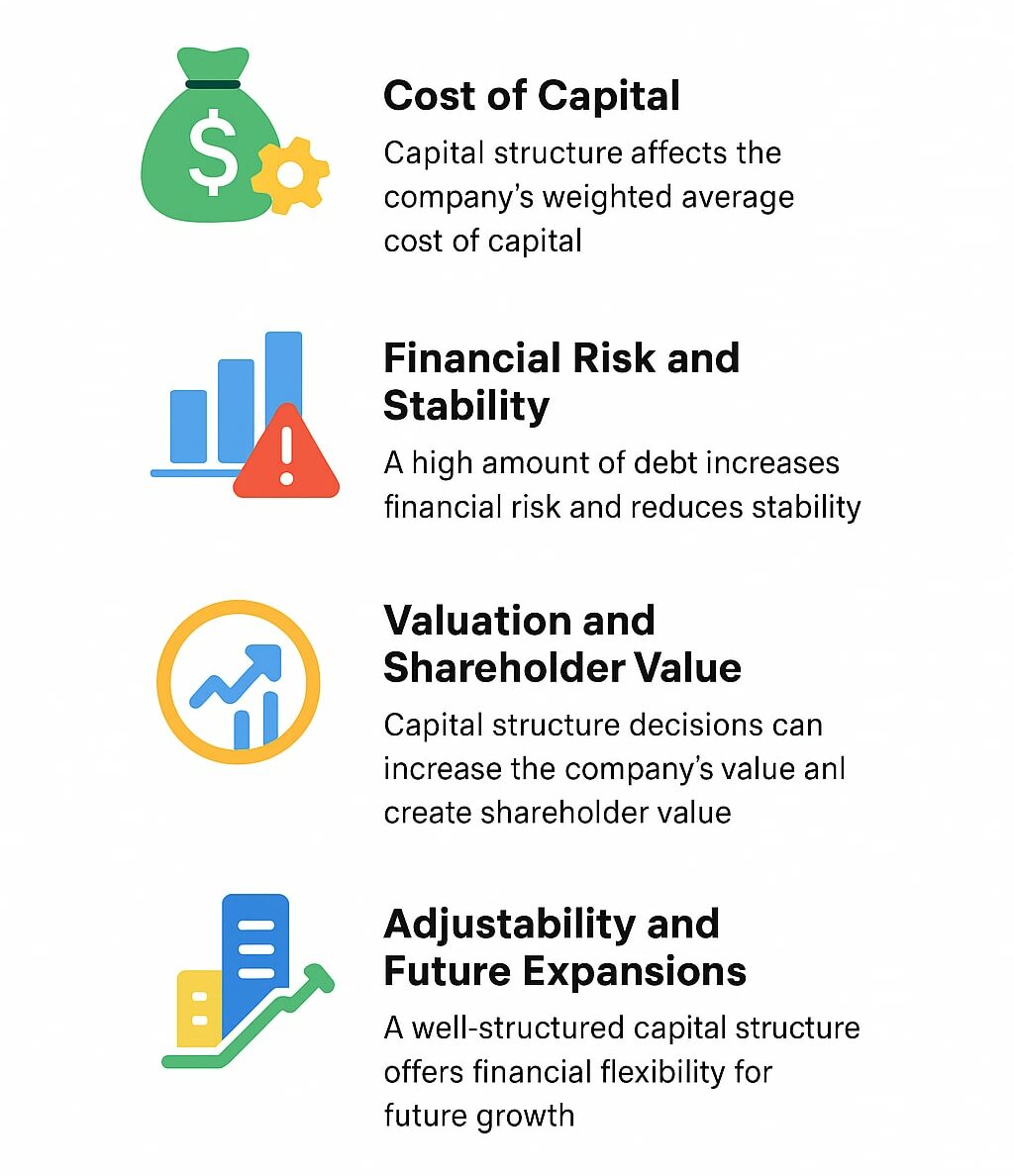Capital Structure: Definition, Types, Importance, and Examples
Table of Contents

During the first quarter of 2025, utility companies worldwide demonstrated a substantial average debt-to-capital ratio, reaching 175.1%. This elevated indebtedness is primarily ascribed to their stable and foreseeable cash flow patterns, coupled with accompanying tax benefits. In contrast, sectors such as coal and combustible fuels maintained a markedly lower ratio, approximately 28.6%. These pronounced discrepancies highlight the paramount importance of comprehending and formulating capital structure strategies within a business context.
What is Capital Structure?
The capital structure of the firm is its particular combination of long-term debt and equity with which it finances its assets and operations. It denotes long-term funding of a business; it is paid using a combination of different funding sources, long-term debt (bonds and long-term loans), and equity (common stocks, preferred stocks, and retained earnings).

An example would be a business with a capital structure that is composed of a 40 percent debt ratio and 60 percent equity. It implies that it has 40 pence (finance through borrowing) and 60 pence (finance through investment of its owners) of assets per pound sterling. This decision in regards to this mix is not arbitrary; it is a well-considered deliberation to reduce the cost of capital and maximize the market value of the company.
Why is it Important for a Business?
The significance of capital structure can be explained by concluding that its influence has a significant impact on the financial performance of a company and its stability and growth. It is the economic pillar of all business activities.

- Cost of Capital: The major factor that makes capital structure significant is the effect it has on the cost of capital. Capital structure affects the weighted average cost of capital (WACC) of the company, which is the average rate of return that the firm anticipates as it pays to its security holders. A better WACC is preferable since it implies less cost of financing the projects run by the firm, potentially translating into higher profitability. Research work conducted by organizations such as the National Bureau of Economic Research has demonstrated that financial leverage (employment of debt is highly correlated with the cost of capital of a firm. In a firm where the issue of capital structure is optimal, the relatively lower cost of debt (because interest is tax-deductible) is balanced with the relatively higher cost of equity so that the lowest possible WACC is attained.
Read Also : 3 Types of Capital Required for Business Finance - Financial Risk and Stability: The debt component of a company’s capital structure is expressly a pointer to that firm about financial risk. A high amount of debt implies the company has fixed commitments (payment of interest and repayment of the principal debt) that it must and cannot avoid making, regardless of whether the company is making profits or losing profits. During economic recession periods, highly leveraged companies are more prone to encounter financial constraints and the declaration of bankruptcy. On the other hand, an equity-driven capital structure is less vulnerable to economic shocks due to the absence of mandatory payments to shareholders. That is why the debt-to-equity ratio of a company is a factor taken seriously by the credit rating agencies when classifying the riskiness of the company to borrow a loan.
- Valuation and Shareholder Value: The capital structure decisions have an immediate effect on the capital structure and valuation of a company, as well as on the generation of shareholder value. The best capital structure can increase the market value of the company by minimizing the WACC. This is founded on the Modigliani-Miller theorem, which under certain assumptions indicates that under certain conditions, the value of a company is not dependent on the capital structure. Nevertheless, in reality, capital structure becomes an important value creation tool due to the effects of factors such as taxes, bankruptcy expenses, and asymmetric information. When a company manages to take advantage of debt, it will elevate its profits per share and market value.
- Adjustability and Future Expansions: Well-structured capital structure gives a business the financial flexibility to provide it with growth opportunities in the future. Any company with a manageable debt level can take up additional financing in the form of new projects, acquisitions, or even to ensure it can tide over an unseen downturn. On the other hand, a highly leveraged company might not be able to raise more funds internally, and thus the company can grow less.
It has been noted that capital structure decisions have been attributed to many business failures, as depicted by a recent report by the Institute of Financial Management, indicating their importance in the long-term survival and success of a business. Thus, appreciating and proactive management of capital structure is not purely a thought experiment; it is the core of strategy management of business.
How Can We Explain Capital Structure with Examples?
The real-world examples can demonstrate capital structure, i.e., by referring to the methods in which various companies finance their activities and development. The decision on the type of financing to use between debt and equity is a strategic decision that indicates the riskiness of a company, industry, among others, and the financial objective of the company.
Example 1: A Tech Startup (Capital Structure that is heavily on equity)
Consider a case of a new technology-based start-up, Name, Innovate Solutions Inc. As a DE, the founders start with personal investments after which they court venture capitalists (VCs) by offering them equity in their venture. The VCs will be willing to invest as they present a high growth potential, even though the startup does not have any tangible assets to put as collateral for a loan. During such an early phase, there are minimal chances that Innovate Solutions Inc. will have a significant utilization of debt. The reason is that banks are not ready to lend to unestablished firms, and the founders would not wish to be caught paying a fixed interest rate, which would ruin their cash flow. The capital structure of the company is thus highly biased to equity and little or no debt. This has the advantage of giving room to maneuver and decreasing the chances of bankruptcy, though it also implies that the founders lost much of their share.
Example 2: A Utility Company (Heavy Weight in Capital Structure in terms of Debt)
Let us now take a big and old utility firm, the PowerGrid Utilities. This firm does not have an uncertain, volatile source of income since the customer base necessitates the use of electricity, independent of economic conditions. It also owns a substantial amount of physical assets, power plants, electrification lines, and infrastructure, which it can utilize as collateral to promote loans. PowerGrid Utilities can deal with a sizable level of debt since its cash flow is strong enough to meet fixed-rate interest payments. The debt will help the company undertake costly projects like the construction of a new power plant at a relatively low cost of debt (KD). It is usually less expensive as compared to selling new shares, which would devalue the interest of current shareholders. The interest amounts are too tax-deductible, which also increases the deductions of the company. This company can afford to have a high level of debt since its risk position is low in business.
What Are the Different Types of Capital Structure in Finance?
The various forms of capital structure are determined by the ratio of debt and equity a business chooses to use as a method of funding the business. A capital structure is a strategic decision that indicates the risk tolerance, the business and financial objectives of the company.
1. Equity-based capital structure
Equity-based capital structure depends mainly on money obtained by shareholders issuing stocks and retained earnings. This form of organization is commonly found with those companies at the initial stages of growth or technology companies undergoing high growth, where the company may lack assets or dependable cash flow to finance loans.
Characteristics:
- Financial Risk will be low since the company cannot experience delays in making interest payments or principal payments, as they are not mandatory. This gives a big monetary latitude.
- Expensive Cost: Equity capital is usually costly compared to debt. Investors who put money into companies with higher risk will require an increase in the rate of return to provide the additional risk incurred, which is reflected in the increased cost of equity.
- Dissolution of Ownership: Dilution occurs when new stock is issued that obliterates the ownership of the existing stockholders of the company, and this could present a significant issue to the founders and the initial investors.
2. Capital Structure based on Debt
Debt-based capital structure highly depends on the use of borrowed funds, which include long-term loans and bonds. It is typical of capital-intensive industries that are stable enough, such as utilities, manufacturing, and real estate, which are characterized by predictable cash flows and have substantial tangible assets that can be employed as collateral.
Characteristics:
- Very High Financial Risk: A very high financial load is caused by fixed interests, as well as principal payments. If the cash flow of the company is not enough to meet such payments, then the company faces a high chance of going bankrupt.
- Low Cost: This is because the cost of debt is usually low when compared to the cost of equity. Interest payments are also deductible in taxes and consequently further lower the net rate of borrowing (the interest tax shield).
- Debt financing does not involve a dilution of ownership to existing shareholders, who are therefore able to keep complete control of the business.
3. Balanced Capital Structure /Hybrid Capital Structure
The balanced or hybrid Capital structure is a mix of debt plus equity financing. This is the most prominent and widely adopted attitude within the existing companies. It aims to make the most efficient capital structure- the proportion of debt and equity that would cost the least weighted average cost of capital (WACC) at a sufficiently low degree of financial risk.
Characteristics:
- Moderate Risk: The company will be in a position to take the benefits of having a low cost of debt and still not cover itself with too much financial risk by using a mix of debt and equity.
- Flexibility: This is because this structure enables the company to access the funding aspects through debt financing and equity financing as required by various projects at various times or arising to meet varying market changes.
- Optimal Value: The ideal composition of debt and equity can enhance the market value of the company since the total amount of debt will lower the WACC and the financial soundness of the company to the stock buyers. A report conducted by one of the largest financial consulting firms in 2023 showed that most of the companies in the S&P 500 have already incorporated a hybrid model to hedge volatility in the market and sustain a competitive cost of capital.
What Factors Affect the Capital Structure of a Company?
The following are the influences that impact the capital structure of a company.
1. Business Risk
Business risk is the risk of doubt in the future operating revenue of the company. Companies that have steady and predictable cash flows, like utility companies, can afford to increase their debt. On the other hand, businesses that operate in industries that are volatile or prone to fluctuations, such as technology start-ups and airlines, are susceptible to considerable business risk and are inclined towards relatively less debt to avoid falling into financial trouble during business bad times. It is the inverse relationship that means the higher the risk of business, the lower the percentage of debt in the capital structure. As one example, a 2023 report published by a financial data provider revealed that utility companies included in the S&P 500 had an average debt-to-equity ratio that was much higher than that of the technology companies.
2. Cost of Capital
Cost of capital is the rate of return that owners of company assets have to pay to the investors to finance their assets. One of the major elements is the variance between the cost of debt (K) and the cost of equity (K)
Usually, debt is less costly since the interest payments are considered a tax deduction, forming an interest tax shield. This is de facto encouraging businesses to optimize their overall weighted average cost of capital (WACC) by the use of a level of debt. Nevertheless, when the level of debt goes up, there is a higher chance of bankruptcy, thus making the cost of debt and equity go up as well. The company should strive to achieve an optimal capital structure, which means the minimum cost of WACC.
3. Tax Rate
The decision regarding the capital structure of a firm tremendously depends on its tax rate. The payment of interest on debt is also deductible, thus trimming down the taxable US-based income of a company, hence its tax-paying obligation. This increases the appeal of using debt as a source of financing instead of investing in equity, where the payment of dividends is made out of after-tax profits. It is one of the principal reasons why several profitable corporations opt to use debt as part of their capital structure.
4. Financial Flexibility
Financial flexibility can be described as the capacity of a company to borrow on good terms to finance to spend in new business or to meet unforeseen demands. A firm that is already heavily geared with plenty of borrowings could be in a poor position to raise additional funds. The lenders can consider such a firm to be a highly risky borrower and either reject a loan or charge an extremely high interest rate. Hence, the companies tend to keep some level of debt capacity to have the financial flexibility for future opportunities.
5. Control
Proprietary factors can also enter into control considerations of capital structure choices. As a company releases new stock of shares to acquire capital, it dilutes the shareholders’ possession of voting rights. A company’s management might feel that its use of debt financing is desirable because it is aimed at avoiding this dilution. This plays a very important role in the case of independent enterprises and startups when the founders wish to maintain as much dominance as practicable.
6. Asset Structure
This largely depends on the nature of the assets of a company. Businesses that have a high ratio of tangible and fixed assets, such as buildings, machinery, and land, can use the assets as security to obtain loans. This will make it simple and cheaper for them to raise debt capital. On the other hand, those with a large percentage of intangible assets (such as patents, brand value, or intellectual property) may have difficulty obtaining debt financing and so depend upon equity financing instead.
7. Management Attitude
It is also dependent on the personal preferences and risk tolerance of the management team and the board of directors of said company. Other managers tend to be cautious and would like a low debt-to-equity ratio so that there is no financial risk involved, although it results in a higher WACC. The others are more aggressive and ready to add more debt to maximize shareholder returns. Capital structure is common in a company that is dominated by the financial philosophy of the company leaders.
How Does Capital Structure Impact Business Growth and Risk?
Capital structure, the debt-equity combination employed by a company, is a strategic decision with great financial impact regarding its growth and risk management capabilities. Such a combination will dictate the financial stability of a company, the cost of capital, and its growth potential. What is desired is a middle ground where the company can take business growth opportunities without risking its finances to unreasonable levels.
The Effects of the Capital Structure Lending to Business Growth
Capital structure is a major growth engine of firms. The manner a firm finances its activities has a direct link with its ability to invest in new ventures, enter new markets, or buy out other companies.
Debt Financing: Debt financing may be used to trigger rapid growth since it brings about a large sum of money without compromising the ownership of the current shareholders. This frequently occurs in firms that are in stable, capital-consuming businesses where the cash flows may be predictable, like utilities or manufacturing. An example would be a firm that has a high credit ranking to get a massive loan at a huge interest rate to construct a new plant to generate more flax and an enlarged market share. The interest charges are also tax-deductible, thus making the effective cost of finance very low. This can also be called the interest tax shield.
Equity Financing: Equity financing is an ideal method of raising financing for high-growth startups, as well as companies with irregular cash flows. It is a sacrifice of ownership, but it does not carry with it the inexorable repayment of debt. This is essential to businesses that might not become profitable at the initial stages. Equity financing also offers the company money to invest into research and development, marketing, or acquisition of talent without incurring the anxiety of paying off the loan, as the revenue is low.
Finally, there exists a classical trade-off in the relation between the capital structure, growth, and risk. Profitable growth and high returns may be sped up by an aggressive capital structure with a lot of debt and higher financial risk. Such conservativeness and heavy equity structure have a low-risk turn, though they may result in other parts of the company growing slowly. The goal of a firm is to determine the question of finding optimal capital structure, which is the particular types of debt and equity that combine to minimize the cost of capital and maintain risk at an acceptable level to maximize the value of the firm.
What Is the Ideal Capital Structure for a Company?
The ideal capital structure for a company is not a fixed formula but rather a dynamic mix of debt and equity that minimizes the weighted average cost of capital (WACC) while maximizing the firm’s market value. This is often referred to as the optimal capital structure. It’s a sweet spot where the benefits of using debt—like the interest tax shield—outweigh the increasing costs and risks associated with higher leverage. There’s no one-size-fits-all answer; what’s ideal for a stable utility company will be completely different from what’s ideal for a high-growth tech startup.
Read Also :What is Capital Budgeting in Corporate Finance?
Optimal Capital Structure Finding
Determining the best capital structure is a risk, which entails considering the advantages and disadvantages of using debt.
Advantages of Debt: The greatest advantage is the interest tax shield. Interest payments can be tax-deductible and hence reduce the tax expenses of a firm, thereby lowering the cost of capital compared with equity. This helps the firms to leverage to reduce the overall WACC a bit.
Costs of Debt: The more a company becomes highly indebted, the greater the financial risk. This increased risk is realised by lenders and investors and increases the cost of borrowing and the cost of equity. At some point, the rising agency cost (conflict of interest between debt holders – bondholders and stockholders – shareholders) and cost of distress (a possible bankruptcy) will make the tax advantages of debt be offset by such cost of distress.
The optimal capital structure may be defined as the one at which WACC is lowest. At this stage, the market value of the stock of the company is at a maximum level since the company is funding its assets in a manner that is as economical as possible.
How Can Businesses Improve Their Capital Structure?
The optimal way to enhance their capital structure is to make a strategic decision on which mix of debt and equity to choose to lower the total cost of capital and retain the flexibility of their finances. It is a matter of balancing between a place where an organization can take advantage of the tax benefits of acquiring debt and not getting too financially vulnerable.
To this end, a business may:
- Optimize the Debt to Equity Ratio: A company can either issue more stock to repay high-interest debt, which will lower the financial risk, which consequently gives strength to the balance sheet. In contrast, a company that is structured conservatively but with a lot of equity can borrow a cheap program to use to generate growth, and this enhances its return on equity. The trick is to regularly re-examine this trade-off concerning the financial status of the company, industry standards, and market situation.
- Control Cost of Capital: Businesses need to continuously seek means of finance at any cost. These include raising credit ratings to secure better loan terms and considering other kinds of funding, including convertible bonds. It is possible to operate the cost of debt and equity at an optimal level to lower its weighted average cost of capital (WACC). With the reduction of the WACC, a business becomes directly more valuable in the market.
- Financial Mobility: A more balanced capital structure can also be described as financial mobility. This is done through not borrowing to the farthest that we can do and remaining with the possibility to borrow more later in unforeseen opportunities or economic decline. Such a strategic reserve ensures an important intra-company safety net and enables the company to be reactive when an opportunity arises.
Jaro Education’s Expert Approach to Career Development
With its personalized and industry-focused approach to career development, Jaro Education empowers learners to align their education with real market demands. Backed by globally recognized programs, expert faculty mentorship, and dedicated career counselors, Jaro ensures that students and working professionals acquire the skills most valued by top employers. Over the years, Jaro has consistently delivered impressive outcomes—with more than 85% of learners advancing to better opportunities, higher roles, or successful career transitions. This strong track record positions Jaro as a leader not only in education but also in shaping thriving, future-ready careers.
Conclusion
To conclude, the choice of capital structure is central in the evaluation of the financial health as well as long-term growth of a company. Knowledge of what capital structure is and the capital structure definition equips businesses with the knowledge to make informed decisions on financing matters. When we define capital structure, it becomes apparent that the perfect balance between debt and equity is capable of minimizing costs in addition to lowering risks and creating value. With the information on the kinds of capital structure and the influences of the capital structure, companies can create a financing mix that suits them and their situation in the market, thus stabilizing and guaranteeing success in the long run.
Frequently Asked Questions
What is Capital Structure and Why is it Important for Businesses?
Capital structure refers to the mix of debt and equity a company uses to finance its operations. It’s important because it impacts the company’s cost of capital, risk profile, and overall financial stability.
What is the Capital Structure Definition in Simple Terms?
The capital structure definition is the way a business organizes its finances using a combination of equity (shareholder funds) and debt (loans, bonds) to support growth and daily operations.
How Can You Explain Capital Structure with an Example?
We can explain capital structure with an example: If a company raises ₹50 lakh from equity shareholders and ₹30 lakh from bank loans, its capital structure is 62.5% equity and 37.5% debt.
What Are the Different Types of Capital Structure in Finance?
The types of capital structure include equity-only, debt-only, and hybrid (a mix of debt and equity). Companies choose based on their risk tolerance, growth goals, and industry standards.
What Factors Affect the Capital Structure of a Company?
Factors affecting capital structure include profitability, asset base, tax rates, industry norms, market conditions, and management’s risk preferences. Each factor influences the debt-equity ratio a firm adopts.


















